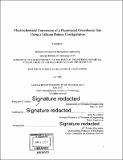Electrochemical conversion of a fluorinated greenhouse gas using a lithium battery configuration
Author(s)
Li, Yuanda
DownloadFull printable version (8.034Mb)
Other Contributors
Massachusetts Institute of Technology. Department of Mechanical Engineering.
Advisor
Betar M. Gallant.
Terms of use
Metadata
Show full item recordAbstract
The demand for technological advancement of greenhouse gas conversion and mitigation strategies is ever increasing. In this thesis, a non-aqueous electrochemical platform with metal lithium (Li) as the anode and carbon as the cathode has been developed to convert the most potent greenhouse gas, sulfur hexafluoride (SF 6), into benign solids Li2S and LiF under room temperature conditions at an electrode - electrolyte interface. Galvanostatic discharge demonstrated that the reaction between Li and SF 6 is capable of delivering modest cell voltages up to - 2.4 V vs. Li/Lie and capacities up to ~3800 mAh/gc. The electrochemical reaction between Li and SF6 in two different battery solvents has been characterized with a suite of solid and liquid phase analyses, which showed the reaction to be an 8 - electron transfer process with high Coulombic efficiency. Rotating disk electrode studies were also employed to demonstrate that the overpotential of this system is intrinsically governed by kinetics. This work demonstrates a non-aqueous system capable of both reducing a fluorinated gas, SF6 under room temperature conditions at an electrode surface, and acting as a primary battery based on halogen ligand chemistry.
Description
Thesis: S.M., Massachusetts Institute of Technology, Department of Mechanical Engineering, 2017. Cataloged from PDF version of thesis. Includes bibliographical references (pages 57-60).
Date issued
2017Department
Massachusetts Institute of Technology. Department of Mechanical EngineeringPublisher
Massachusetts Institute of Technology
Keywords
Mechanical Engineering.